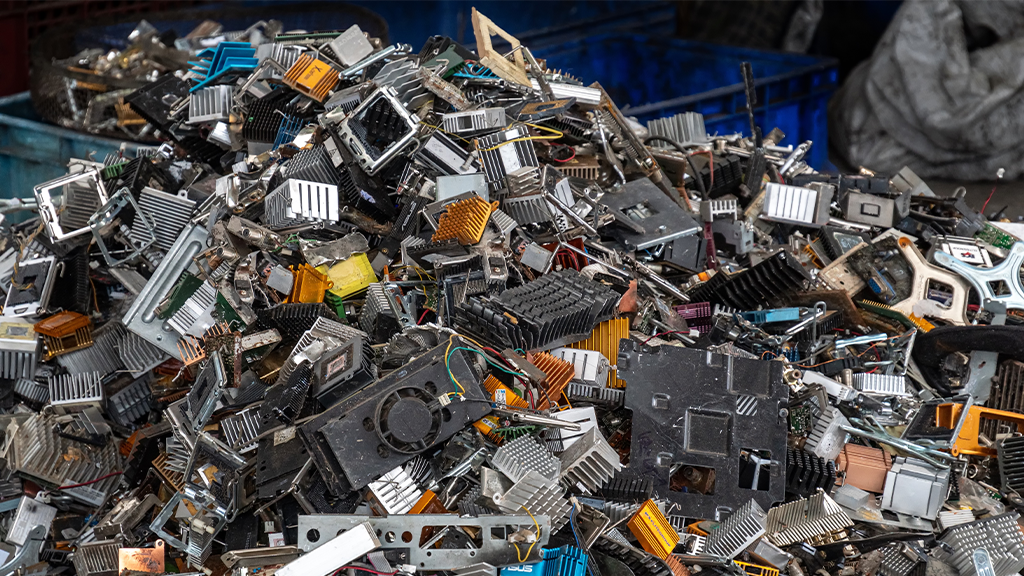Alberta remains stalled on recycling
Managing E-Waste, Used Oil and implementing EPR needs attention in Canada’s “Most wasteful province”
Alberta remains the most wasteful province in Canada, with a per-capita waste generation of just under 1,000 kg/person/year, compared to a Canadian average of 700 kg, and a Nova Scotia rate of under 400 kg. This represents significant environmental impact, a huge waste of resources and lost economic opportunity.
A lack of provincial leadership on the waste file leaves Alberta municipalities with the burden of reducing the negative impacts associated with waste. In 2013, Alberta Environment and Parks announced plans to change Alberta's existing regulatory framework for designated materials recycling, as follows:
• The creation of the "Designated Materials Recycling Regulation," which will consolidate all eight of Alberta's existing recycling regulations;
• Removal of environmental fees from regulation;
• Expansion of the electronics program to include additional products;
• Expansion of the "Used Oil Recycling Program" to include automotive fluid containers and increase the current fee for containers;
• Enabling Extended Producer Responsibility (EPR) in Alberta;
• Designation of materials that will require EPR programs.
Despite consultations that delivered positive feedback on these proposed changes in late 2013, no further progress has been made to implement them.
As an example to highlight the challenges faced by Alberta's current recycling stewardship programs, the fees on lubricating oil are set out in regulation and have not been updated in 20 years. They no longer cover the costs of collection and recycling. As a result, the Alberta Used Oil Management Association (AUOMA) had an operating deficit in 2016, and 134 public used oil collection sites closed in the last two years. If increased fees are not imminent, the entire program is in jeopardy, potentially downloading used oil management onto municipalities, or leaving it unmanaged in many jurisdictions.
Alberta's programs have also not kept up with the evolution to expand their scope across a wider range of materials. Despite having the first provincial electronics stewardship program (introduced in 2004), Alberta is the only province that has not expanded its program beyond Phase 1 materials that include televisions, computers, printers and monitors. Despite this, other electronics such as small appliances, power tools and audio-visual equipment often end up in municipal waste management programs. These products increasingly are included in provincial electronics programs across the country, but remain outside Alberta's program.
Alberta has also fallen behind the rest of the country in implementing EPR programs that place increased financial and program responsibility for waste management on producers, shifting that burden from municipalities and taxpayers. The Canada-Wide Action Plan on EPR, developed by the Canadian Council of Ministers of the Environment (CCME), laid out a schedule for EPR implementation, fostering the development of an increasing number of EPR programs across the country. Alberta has not upheld its obligations in this regard, specifically related to packaging and Household Hazardous Waste (HHW). Alberta Environment and Parks held public consultations on EPR (also in late 2013), but no further action has taken place.
There is a need for Alberta to develop solutions for products such as packaging and printed materials through introduction of an EPR regulation, capturing both residential and commercial waste streams. Other provinces have demonstrated leadership by developing EPR programs for an expanding range of materials. British Columbia, as an EPR leader, has adopted an EPR approach to a wide range of products, including packaging and printed materials. Thanks to this approach, municipalities in British Columbia are saving more than $74 million per year as packaging producers have removed the cost and burden of residential packaging recycling from municipal balance sheets. Looking forward, Ontario is set to further advance the EPR model within a Circular Economy framework.
Alberta clearly needs to get on board soon to update its lagging recycling regulations, and embrace the new national EPR paradigm. With this in mind, the RCA has a number of relevant sessions planned at the It Takes a Village conference October 11-13 in Lake Louise, including updates from Ontario and B.C. We hope to see you there for fruitful discussions on the future of waste reduction.
Christina Seidel holds a PhD in Engineering Management, a Masters degree in Environmental Design (Environmental Science), as well as a B.Sc. in Mechanical Engineering. She operates sonnevera international corp., a waste reduction consulting firm, and is the current executive director of the Recycling Council of Alberta.
This article was originally published in Recycling Product News, September 2017, Volume 25, Number 6.



